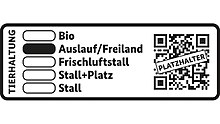
| Tierhaltungskennzeichnungsgesetz - TierHaltKennzG (Act on Animal Husbandry Labelling) | |
|---|---|
| Bundestag | |
Long title
| |
| Territorial extent | Germany |
| Enacted by | Bundestag |
| Enacted | 16 June 2023 |
| Assented to by | Bundesrat |
| Assented to | 7 July 2023 |
| Signed by | President of Germany |
| Signed | 17 August 2023 |
| Effective | 24 August 2023 |
| Committee responsible | Ausschuss für Ernährung und Landwirtschaft [de] |
| Status: In force | |
Animal Husbandry Labelling (German: Tierhaltungskennzeichnung) is the mandatory labelling of the living conditions of livestock animals originating in Germany. It is in force for pigs during their fattening period since August 2023. The law (federal Act on Animal Husbandry Labelling) was developed by the Greens-led German ministry of agriculture, BMEL, under Cem Özdemir.
Label
The labelling Act, which follows the cabinet draft, stipulates that only animal products need to be labelled that both originate in Germany and are also sold in Germany. Labelling is to be phased in gradually, starting with pig meat.
The label only describes the animals' living conditions during their "productive period". For pig meat, this refers to the fattening period, and ignores living conditions during piglet and sow rearing. The label distinguishes the following five living conditions (from best to worst):
- EU organic certified,
- Outdoor runs/free-range,
- Indoor with fresh air,
- Indoor+space,
- Indoor housing.
Criticism
Requiring a label only from German producers disadvantages them compared to foreign ones selling in Germany, Peter Hauk of the Christian Democrat opposition argued during the Bundesrat discussion of the cabinet draft. The Bundesrat demanded that foreign producers also be forced to use the label.
However, forcing the label on foreign producers would violate European Union and World Trade Organization law. The planned label can be used voluntarily by foreign producers.
See also
References
- "Cabinet Adopted Draft Act on Animal Husbandry Labelling". BMEL. 2022-10-12.
- tagesschau.de. "Kabinett billigt Tierhaltungskennzeichnung: Kritik von Landwirten und Tierschützern". tagesschau.de (in German). Retrieved 2022-12-14.
- "Deutscher Bundestag - Bundestag beschließt ein staatliches Tierhaltungslabel für Schweinefle..." Deutscher Bundestag (in German). Retrieved 2023-07-31.
- ^ "Future-proof animal husbandry - Cornerstones for the introduction of mandatory state animal husbandry labelling" (PDF). BMEL.
- ^ "Fragen und Antworten zur Einführung einer verpflichtenden staatlichen Tierhaltungskennzeichnung". BMEL (in German). 2022-10-12.
- Michel, Johanna (2022-11-25). "Tierhaltungskennzeichnung: Bundesländer unterstützen Özdemir". agrarheute (in German). Retrieved 2022-12-14.